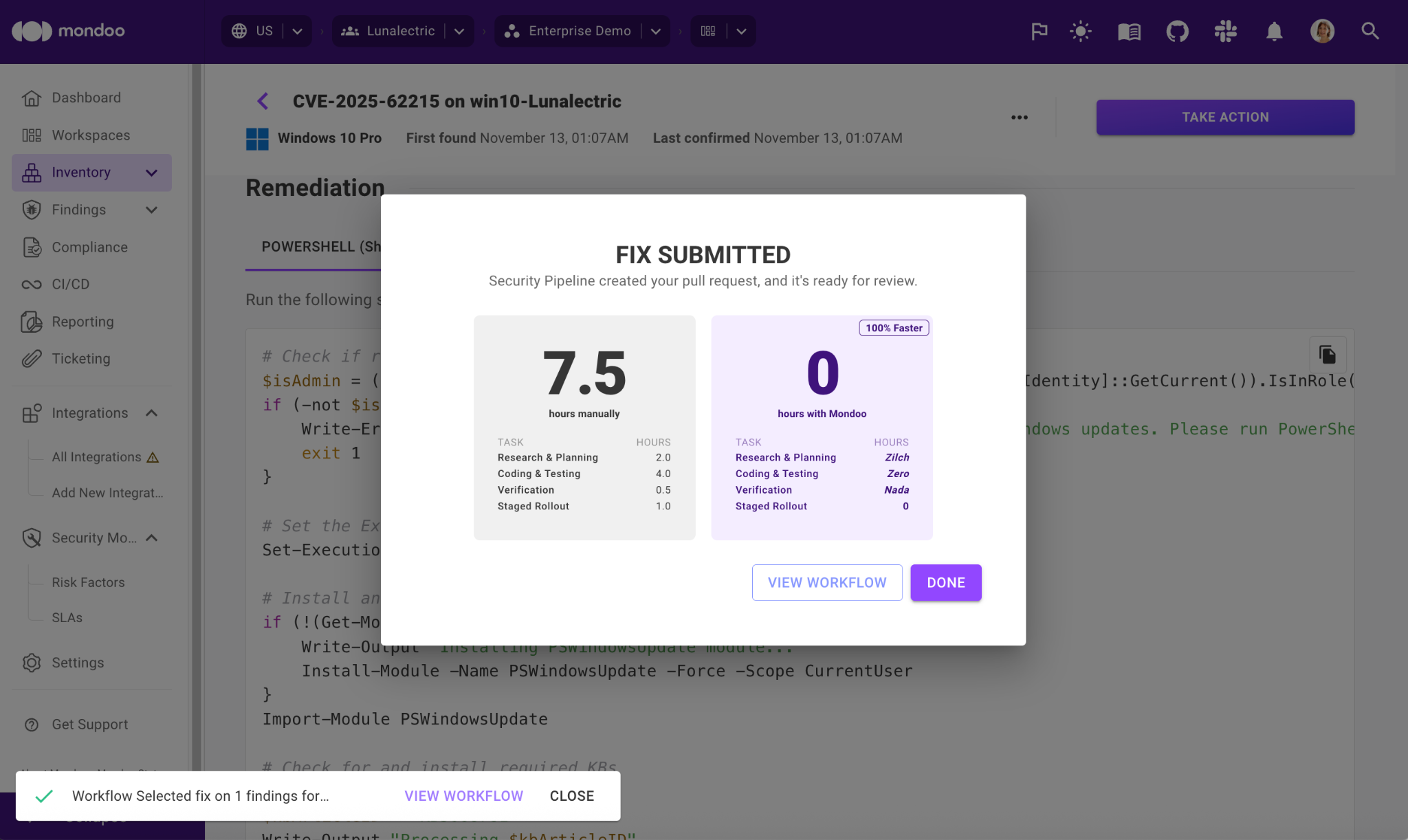Four critical vulnerabilities in November Patch Tuesday
November’s Patch Tuesday fixes four critical vulnerabilities. We’ve listed them below in order of importance:
1. CVE‑2025‑62215 – Windows Kernel Elevation of Privilege (Zero-Day)
This vulnerability is the most critical since not only has it been rated a base CVSS score of 7.0, it’s also being actively exploited in the wild and now listed on the CISA KEV catalog. It allows attackers to exploit a race condition in the Windows Kernel (improper synchronization of shared resources) to gain SYSTEM-level privileges. Once local access is achieved, full system control may follow. This vulnerability affects Windows 10 and 11.
What you need to do: Patch immediately, especially machines with privileged users, servers, domain controllers, etc. See affected systems and applicable security updates.
If you're still running Windows 10, even though it reached end-of-life on October 14th, make sure you have purchased Extended Security Updates (ESU) so you can patch your system. Alternatively, either upgrade to another operating system or ensure mitigating controls are in place.

2. CVE‑2025‑60724 – GDI+ Remote Code Execution
This vulnerability is a heap-based buffer-overflow in the Microsoft Graphics Component (GDI+). It has a CVSS score of 9.8 and allows remote code execution without authentication by processing a specially crafted metafile (for example embedded in a document). This is a high risk and easily exploitable vulnerability.
What you need to do: Patch any affected devices immediately, prioritize devices that handle documents, share files via applications, or parse uploaded files in services. See affected systems and applicable security updates.
3. CVE‑2025‑62220 – Windows Subsystem for Linux (WSLg) Remote Code Execution
This is a heap-based buffer overflow vulnerability in the Windows Subsystem for Linux (WSL) GUI component and has a CVSS base score of 8.8. Attackers could execute arbitrary code via crafted inputs. While WSL may be less common in some enterprise endpoints, systems using WSL (especially dev/test machines or servers) are vulnerable.
What you need to do: Ensure WSL GUI users and dev machines are patched promptly. See affected systems and applicable security updates.
4. CVE‑2025‑62199 – Microsoft Office Use-After-Free / RCE
This Use After Free (UAF) vulnerability in Microsoft Office allows an unauthorized attacker to execute code locally. UAF vulnerabilities occur when a program tries to access a memory location after it has been deallocated or "freed". Though less critical than the three listed above, this vulnerability could lead to an RCE, and since Office is widely used and allows for document-based attach vectors, could be one that attackers will be looking to exploit.
What you need to do: Include Office systems (especially those opening external/shared docs) in patching as part of your rollout. See affected systems and applicable security updates.
Patching affected systems
By using Mondoo as your vulnerability management platform, you can quickly see which devices and assets are vulnerable to these CVEs and immediately apply the correct patch, since Mondoo provides it for you.

In the case of CVE-2025-62215 for instance, Mondoo provides you with a PowerShell script that you can copy and paste to apply the patch. All fixes that Mondoo provides have been pre-tested by humans, so you can apply them with confidence.
Creating tickets
With Mondoo's ITSM integrations, security engineers can create tickets directly from the Mondoo platform. Each ticket will include detailed information on the vulnerability, contextual risk factors, full asset details, and remediation instructions. This enables platform engineers to take quick action without requiring back and forth with the security team. Mondoo will track the progress of the ticket, validate whether the issue is fixed, and automatically reopen the ticket if drift occurs.
Autonomous vulnerability patching
In addition, Mondoo offers agentic vulnerability patching, a fully transparent system based on tried and tested, easy to use, open source technologies that provides semi-autonomous patching and allows engineers to see exactly what is happening and easily rollback if necessary. When using Mondoo’s security pipeline, you can choose to automatically create a pull request in GitHub so the IT team can review and approve the request in a matter of minutes. Mondoo will track and verify the patch, to make sure it is successful.

Find and fix the security risks that pose the biggest threat to your business.
Ready to leave your attackers in the dust?
Final recommendations
Here are some final recommendations we’ll leave you with:
- Prioritize the zero-day (CVE-2025-62215) and the remote-code-execution flaws (CVE-2025-60724, CVE-2025-62220).
- Even though other vulnerabilities in the Tuesday Patch may be less critical, in aggregate they still pose risk, so it’s still important to remediate them.
- If you have unsupported OS versions (for example Windows 10 that reached EOL) make sure you upgrade as soon as you can.
About Mondoo
Mondoo is the world’s first agentic vulnerability management platformTM that eliminates - not just categorizes - vulnerabilities. Global enterprises trust Mondoo to prioritize risks by business impact and exploitability through its patented AI-native security model that collects structured, context-aware data from the entire IT infrastructure. Mondoo’s customers have reduced vulnerabilities and policy violations by 50% and significantly reduced MTTR. With seamless ITSM integrations and transparent security pipelines, Mondoo enables autonomous remediation and continuous compliance. Mondoo bridges the gap between security and engineering - delivering intelligent recommendations and actionable insights to fix vulnerabilities that matter most to the business.
Want to learn more? Schedule a demo today.









